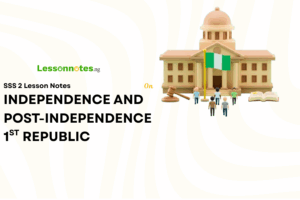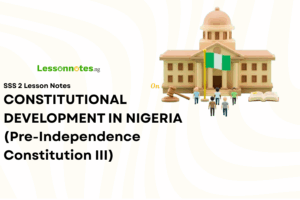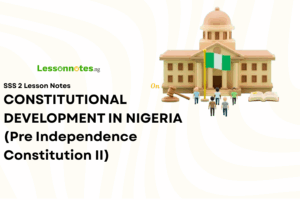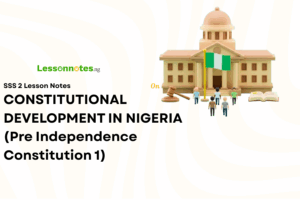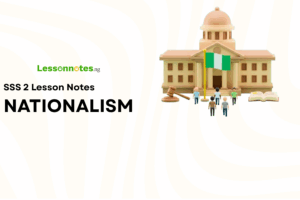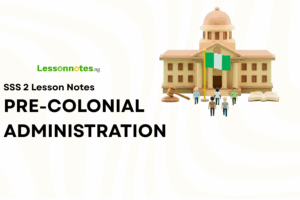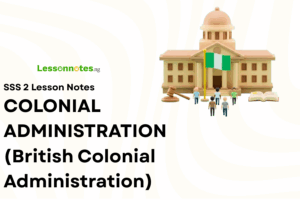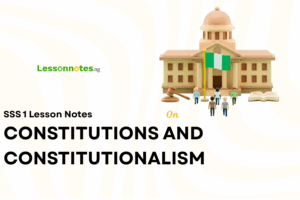Parliamentary System of Government SS1 Government Lesson Note
Download Lesson NoteTopic: Parliamentary System of Government
Parliamentary System of Government
It is a system of government whereby the head of state is separated from the head of government in terms of personalities and functions. It is also called a cabinet system. The head of state may be called queen, Emperor, General or President while the head government is tagged, Prime minister. Examples of Entries operating this system are; Britain, Kenya, Zambia, Zimbabwe
Functions Of A Cabinet In A Parliamentary System Of Government
The functions of a cabinet are varied:
- In some countries, it is a collegial decision-making body with collective responsibility, while in others it may function either as a purely advisory body or an assisting institution to a decision-making head of state or head of government.
- In some countries, the cabinet is called “Council of Ministers” or “Government Council” or lesser-known names such as “Federal Council” (in Switzerland), “Inner Council” or “High Council”. These countries may differ in the way that the cabinet is used or established.
- In some countries, particularly those that use a parliamentary system (e.g., the UK), the Cabinet collectively decides the government’s direction, especially regarding legislation passed by the parliament.
- In countries with a presidential system, such as the United States, the Cabinet does not function as a collective legislative influence; rather, its primary role is as an official advisory council to the head of government. In this way, the President gets opinions and advice on upcoming decisions.
Collective Responsibility
Cabinet collective responsibility, also known as collective ministerial responsibility, is a constitutional convention in governments using the Westminster System that members of the cabinet must publicly support all governmental decisions made in Cabinet, even if they do not privately agree with them.
This support includes voting for the government in the legislature. Some Communist political parties apply a similar convention of democratic centralism to their central committee. If a member of the cabinet does wish to openly object to a cabinet decision then they are obliged to resign from their position in the cabinet.
Cabinet collective responsibility is related to the fact that, if a vote of no confidence is passed in parliament, the government is responsible collectively, and thus the entire government resigns.
The consequence will be that a new government will be formed, or parliament will dissolve and a general election will be called. Cabinet collective responsibility is not the same as individual ministerial responsibility, which states that ministers are responsible and therefore culpable for the running of their departments.
Features of a Parliamentary System
- All ministers are chosen from the legislature.
- The prime minister and key ministers are directly responsible to the legislature for any policy initiated by them.
- There is the principle of collective responsibility.
- The party that has the majority in the legislature forms the government.
- There is strong party discipline.
- There is a fusion of powers.
Merits Of A Parliamentary System Of Government
- It encourages a great working relationship
- The cabinet system makes the executive indirectly responsible to the people through legislation.
- It encourages team spirit among the cabinet ministers.
- The official opposition serves as an effective watchdog on the government.
- Party discipline facilitates quick decision-making.
Demerits Of A Parliamentary System Of Government
- A parliamentary system is often unstable when a coalition government is formed.
- The principle of collective responsibility makes it difficult to allocate praise and blame particular minister.
- The fusion of power may lead to dictatorship.
- Party discipline kills the individual initiative of the ministers and the legislature.
The Difference Between A Parliamentary And Presidential System Of Government
- The major difference between these two systems is that in a Presidential system, the executive leader, the President, is directly voted upon by the people (or via a body elected specifically to elect the president, and no other purpose), and the executive leader of the Parliamentary system, the Prime Minister, is elected from the legislative branch directly.
- In the Presidential System, it is more difficult to enact legislation, especially if the President has different beliefs than the legislative body. The President only responds to the people, the legislative branch can’t do anything to threaten the President. As a result, he can make it more difficult for the legislative body to do anything.
- In the Parliamentary system, if the Parliament doesn’t like the Prime Minister, they can cast a vote of no confidence and replace him. This tends to make the executive leader subservient to the Parliament.
In conclusion, if you believe that the government should have more checks and balances, then a Presidential system will give you that. If you believe that it should have the power to enact laws quickly, then you should go for a Parliamentary system.







